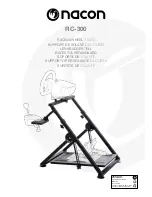
D-5
Rev 2.2, 10/31/94
Dynamic Microphone
A dynamic microphone consists of a diaphragm with a coil of wire attached to it
such that sound pressure moving the diaphragm causes the coil to move in a magnetic field supplied by
a permanent magnet. Motion of the coil causes an electric current to be induced in it, and this is the
signal output of the microphone. It is similar to a dynamic loudspeaker operating in reverse. (TAD)
Dynamic Range
The dynamic range of a sound is the ratio of the strongest, or loudest, part of the
weakest, or softest, part; it is measured in
decibels
. A full orchestra may have a dynamic range of 90 dB,
meaning the softest passages are 90 dB less powerful than the loudest ones. Dynamic range is a power
ratio, and has nothing to do with the absolute level of the sound.
An audio signal also has a dynamic range, which is sometimes confused with signal-to-noise ratio. Rarely
is the dynamic range of an audio system as large as the dynamic range of an orchestra because of several
factors. The inherent noise of the recording medium determines the softest possible recorded sound, and
the maximum signal capacity of the system (
clipping
level) limits the loudest possible sound. Many times
an extremely wide dynamic range is not desirable (e.g., in radio broadcasting for listening in cars) and
broadcasters frequently use
compressors
and
limiters
to reduce the dynamic range of the signals before
they are transmitted. This type of signal processing distorts the music in a more or less noticeable way,
symphonic music being most sensitive to it. (TAD)
Echo
Commonly used incorrectly to mean
reverberation
, echo, technically is a discrete sound reflection
arriving at least 50 milliseconds after the direct sound. It also must be significantly above the level of the
reverberation at that time.
"Echo chambers" are reverberation rooms which are carefully designed to be without echoes. If an actual
echo is desired in a recording, a tape recorder is sometimes used to add a time delay (tape delay), the
delay representing the time it takes the tape to move between the record and reproduce heads. This is
called "tape echo," and is appropriate usage. A popular way to get the same effect is to use a digital time
delay system (
digital delay
), where the time delay is variable. (TAD)
Equalizer
An equalizer, contrary to what its name implies, alters or distorts the relative strength of
certain frequency ranges of an audio signal. In a sense, it should probably be called an "unequalizer."
However, the first equalizers were used to make the energy at all frequencies equal, or to achieve "flat
response," in telephone lines, and this is where the term originated. Another early use of equalizers was
in the sound motion picture industry, where they were used to improve intelligibility in film sound
tracks. Later on, equalizers were found useful for creating special sound effects in the early days of radio
and movies, where they are extensively used to this day. All equalizers are made up of various circuits
called
filters
, which are frequency-selective networks containing resistors (R), capacitors(C), and
inductors (L). Normally filters attenuate certain frequency ranges and do not boost them; however some
equalizers that boost the signal are called filters.
An equalizer can boost or attenuate a certain frequency band, but in common usage, equalize means to
boost. The preferred terminology for the actual process is boost/cut rather than equalize/attenuate. In
Britain preferred usage is lift/dip.
Equalizers that can have peaks in their response curves (such as
parametric
and graphic equalizers) are
characterized by the relative sharpness of the peaks. The Q of a filter is a measure of this sharpness and
is defined as the center frequency divided by the half-power bandwidth. For instance, a one-third octave
filter centered at 1000 Hz will be 232 Hz wide at its half-power points. Its Q is thus 1000/232, or 4.31.
Filters with Q values much higher than this tend to "ring," distorting transients, and call attention to
themselves when used in sound systems.
See also:
Q
,
parametric equalizer, shelving equalizer
.
(TAD,
abridged)
Expander
A device for increasing the dynamic range and reducing the apparent noise of a signal. A
volume expander decreases the system gain as the signal level decreases, making soft signals softer still.
This results in an apparent noise decrease because the relative level between the softest and loudest
sounds is greater. If the noise level is already low enough that the signal will mask it in the loud
passages, the expansion will put the low end of the dynamic range at a point where the ear has reduced
sensitivity, making the noise less audible (TAD). This definition for an expander is commonly used for
downward expanders as well.
Filter
A filter is a type of
equalizer
which is designed to reduce the energy at a certain frequency or in a
certain frequency band. Filters always act as subtractive devices, never adding anything to a signal; at
least they should not. The most common types of filters are
analog
filters, which operate on signals
directly.
Summary of Contents for 601
Page 46: ...4 18 Rev 2 2 10 31 94 This page is blank believe it or not ...
Page 48: ...4 20 Rev 2 2 10 31 94 Notes ...
Page 50: ...5 2 Rev 2 2 10 31 94 Notes ...
Page 70: ...7 16 Rev 2 2 10 31 94 Notes ...
Page 72: ...8 2 Rev 2 2 10 31 94 Notes ...
Page 74: ...9 2 Rev 2 2 10 31 94 Notes ...
Page 78: ...11 2 Rev 2 2 10 31 94 Notes ...
Page 126: ...D 12 Rev 2 2 10 31 94 Notes ...
Page 138: ...G 8 Rev 2 2 10 31 94 Notes ...
















































